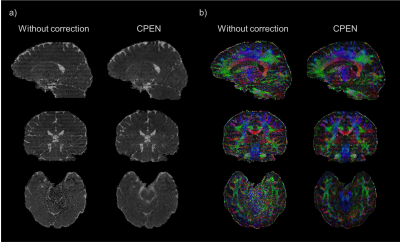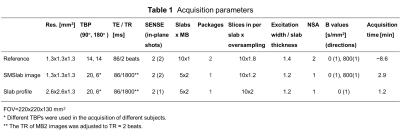3531
Convolutional Neural Network for Slab Profile Encoding (CPEN) in Simultaneous Multi-slab (SMSlab) Diffusion Weighted Imaging1Center for Biomedical Imaging Research, Department of Biomedical Engineering, Tsinghua University, Beijing, China, 2MR Clinical Science, Philips Healthcare, Suzhou, China
Synopsis
Simultaneous multi-slab (SMSlab) is a 3D acquisition method that can achieve optimal SNR efficiency for isotropic high-resolution DWI. However, boundary artifacts restrain its application. Nonlinear inversion for slab profile encoding (NPEN) seems to be inadequate for boundary artifacts correction in SMSlab. In this study, we proposed to use a model-based convolutional neural network (referred as CPEN) for this problem. According to the results, it outperforms NPEN in images with different resolutions, and the computation is much faster. Using CPEN, small oversampling factors can be used to reduced the acqsuition time, which is of great meaning for high-resolution whole-brain DWI.
Introduction
In simultaneous multi-slab (SMSlab) acquisition, multiple 3D slabs are excited simultaneously. It can achieve the optimal signal-to-noise ratio (SNR) efficiency for high-resolution whole-brain diffusion weighted imaging (DWI)1. However, boundary artifacts restrain its application2-4. Similar as the boundary artifacts in multi-slab2,3,5-7, the artifacts manifest as intensity variation and aliasing in the slice direction, which mainly result from the truncated RF pulses. However, in SMSlab, they are more severe. The SMSlab pulses are the summation of multiple pulses, so the pulse durations are prolonged (Fig.1a). The RF pulses have to be further truncated to ensure a short echo time (TE). Moreover, the intra-slab aliasing in multi-slab turns out to be inter-slab aliasing in SMSlab (Fig. 1b).Nonlinear inversion for slab profile encoding (NPEN)2 can solve the boundary artifacts in multi-slab, and it was adapted for SMSlab1,8. However, its computation is time-consuming, and residual artifacts still exist in the results8. Inspired by NPEN, we proposed to reduce the boundary artifacts using a convolutional neural network (CNN) for slab profile encoding (CPEN) in SMSlab.
Methods and materials
TheoryIn image domain, the boundary artifacts in SMSlab can be formulated as Eq. 1. $$ E(x)=A S \mu=I \qquad \qquad [1]$$ $$x=[\mu, S]^{T} \qquad \qquad [2]$$ $$$I$$$ is the image with boundary artifacts; $$$\mu$$$ is the artifact-free image; $$$S$$$ is the concatenation of the slab profiles; $$$A$$$ represents the inter-slab aliasing pattern. The reconstruction is a non-linear inversion problem2. If Gauss-Newton algorithm is used, the iteration will be like Eq.3. $$E^{\prime}\left(x_{n-1}\right) \Delta x_{n-1}=I-E\left(x_{n-1}\right) \qquad \qquad [3]$$ $$$E^{\prime}\left(x_{n-1}\right)$$$ is the Fréchet derivate of $$$E\left(x_{n-1}\right)$$$ at the current guess $$$x_{n-1}$$$; $$$\Delta x_{n-1}$$$ is the update at the $$$n$$$th iteration. Rather than solving Eq.3 using least square solution, in CPEN, the optimal solution of $$$\Delta x_{n-1}$$$ is learnt from the training data. As shown in Fig. 2, the unrolled iterative network consists of K repeated CNN blocks. Each block takes $$$E^{\prime}\left(x_{n-1}\right)$$$ and $$$x_{n-1}$$$ as input, and generates $$$x_{n}$$$.
The model is trained with a composite loss function inspired by NPEN2. $$\operatorname{loss} =d S S I M+\lambda_{1}\left\|I-E\left(x_{n}\right)\right\|_{2}^{2}+\lambda_{2}\left\|x_{n}-x_{0}\right\|_{2}^{2}+\lambda_{3}\left\|W F \mu_{n}\right\|_{2}^{2}+\lambda_{4} \text {loss}_{\text {smooth}} \qquad \qquad [4]$$ $$$\lambda_{1}$$$, $$$\lambda_{2}$$$, $$$\lambda_{3}$$$ and $$$\lambda_{4}$$$ are the weights of the loss functions. $$$d S S I M$$$ is structural dissimilarity9. $$$F$$$ represents fast Fourier transform.$$$W$$$ is a weight matrix with large values at the spike frequencies. $$$\text {loss}_{\text {smooth}}$$$ is the in-plane variance of $$$S_{n}$$$, which constrains the slab profiles to be smooth.
Image acquisition
For the training set, images of 9 healthy subjects were acquired with 1.3 mm isotropic resolution. Each acquisition contained reference, SMSlab images and slab profiles. The reference images were acquired with cardiac trigger, and multi-slab was used for RF pulses with higher time-bandwidth-products (TBPs). The TE and repetition time (TR) of the SMSlab images kept the same as those in the reference. Different TBPs were used, so the network could be exposed to different levels of artifacts. The other parameters are listed in Table1.
The model was tested on 3 datasets excluded from the training set. Two of them included reference images. They were acquired with 1.3 mm and 1 mm isotropic resolution, respectively. For the test data, the nominal excitation width of the reference and the SMSlab images were adjusted to ensure comparable SNRs of these two sequences. Another test dataset with 1 mm isotropic resolution consisted of 32 directions. Fractional anisotropy (FA) and mean diffusivity (MD) maps were calculated using FDT from FSL10. NPEN was also used for comparison.
Results and Discussion
Fig.3 shows the results of test datasets. Residual artifacts (yellow arrows) are visible in SMSlab NPEN. The results of CPEN are more close to the reference images, except for the slight artifacts in the cerebrospinal fluid (CSF) regions, which has little impact on DWI. As for the reference images, the TRs might be inconsistent among different slabs and shots because of the cardiac triggering, so the intensity variation may occur sometimes. The acquisition time of the reference images is more than twice longer than that of the artifact images. That is, using CPEN, small oversampling factors can be used to save the acquisition time. The computation time of 1 volume on CPU is 2 mins and 84 mins for CPEN and NPEN, respectively. CPEN is faster, because it reduces the computational complexity by using single-channel data and used CNN for fast computation.Fig.4 shows the FA and MD maps of the 32-direction dataset. Without correction, the SNR of the edge slices is so low that the noises in the FA map prevent us from identifying the anatomical structure, and the MD maps also show obvious artifacts. CPEN shows an effective suppression of noise. It significantly increased the SNR of the edge slices.
Conclusion
We proposed a model-based CNN, CPEN, for boundary artifacts correction in SMSlab. CPEN outperforms NPEN in images with different resolutions. CPEN takes advantages of both model-based and data-driven methods. It’s more robust, and its computation is much faster than NPEN. Therefore, CPEN is very promising for boundary artifacts correction in SMSlab, especially when a large number of volumes are acquired. It can also be extended to boundary artifacts correction in multi-slab.Acknowledgements
No acknowledgement found.References
1. Dai E, Wu Y, Wu W, et al. A 3D k-space Fourier encoding and reconstruction framework for simultaneous multi-slab acquisition. Magnetic Resonance in Medicine 2019;82(3):1012-1024.
2. Wu WC, Koopmans PJ, Frost R, Miller KL. Reducing Slab Boundary Artifacts in Three-Dimensional Multislab Diffusion MRI Using Nonlinear Inversion for Slab Profile Encoding (NPEN). Magnetic Resonance in Medicine 2016;76(4):1183-1195.
3. Van AT, Aksoy M, Holdsworth SJ, Kopeinigg D, Vos SB, Bammer R. Slab Profile Encoding (PEN) for Minimizing Slab Boundary Artifact in Three-Dimensional Diffusion-Weighted Multislab Acquisition. Magnetic Resonance in Medicine 2015;73(2):605-613.
4. Engstrom M, Skare S. Diffusion-Weighted 3D Multislab Echo Planar Imaging for High Signal-to-Noise Ratio Efficiency and Isotropic Image Resolution. Magnetic Resonance in Medicine 2013;70(6):1507-1514.
5. Engstrom M, Martensson M, Avventi E, Skare S. On the Signal-to-Noise Ratio Efficiency and Slab-Banding Artifacts in Three-Dimensional Multislab Diffusion-Weighted Echo-Planar Imaging. Magnetic Resonance in Medicine 2015;73(2):718-725.
6. Kholmovski EG, Alexander AL, Parker DL. Correction of slab boundary artifact using histogram matching. J Magn Reson Imaging 2002;15(5):610-617.
7. Xiaoxi Liu DC, Xucheng Zhu, Edward S. Hui, Queenie Chan, Peder EZ Larson, Hing-Chiu Chang. Sliding-Slab Profile Encoding (SLIPEN) for Eliminating Slab Boundary Artifact in Three-Dimensional Multi-slab Diffusion-Tensor Imaging. ISMRM. Paris, 2020. p.
8. Wu Yuhsuan DE, Yuan Chun, Guo Hua. Reducing slab boundary artifacts in 3D multi-band, multislab imaging. KSMRM. Seoul2018. p FA-086.
9. Wang Z, Bovik AC, Sheikh HR, Simoncelli EP. Image quality assessment: from error visibility to structural similarity. IEEE transactions on image processing 2004;13(4):600-612.
10. Jenkinson M, Beckmann CF, Behrens TEJ, Woolrich MW, Smith SM. FSL. NeuroImage 2012;62(2):782-790.
Figures




